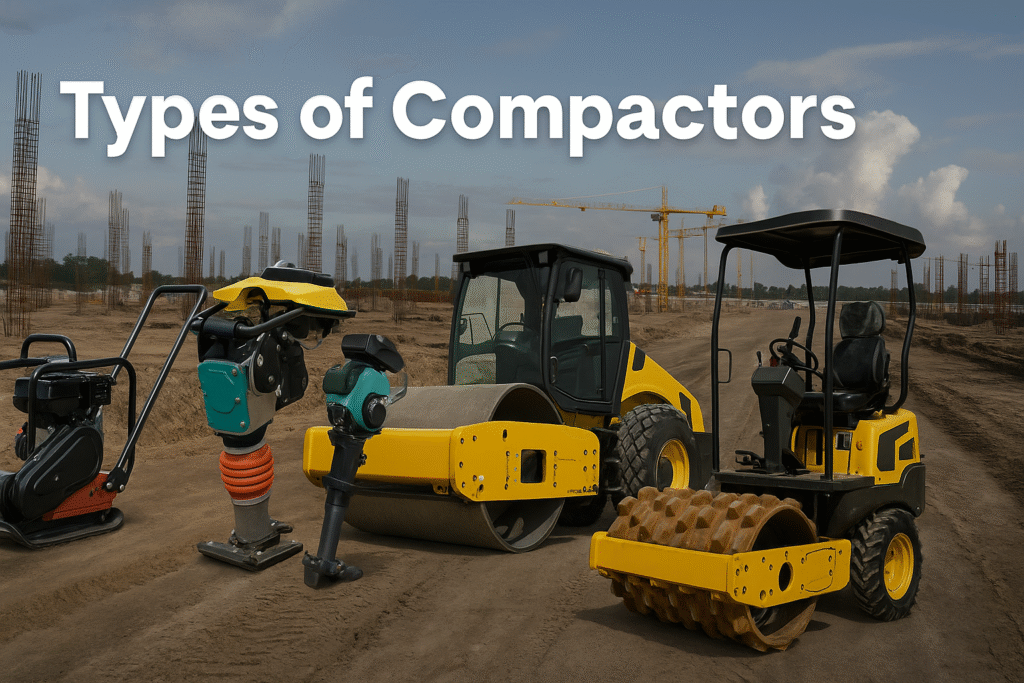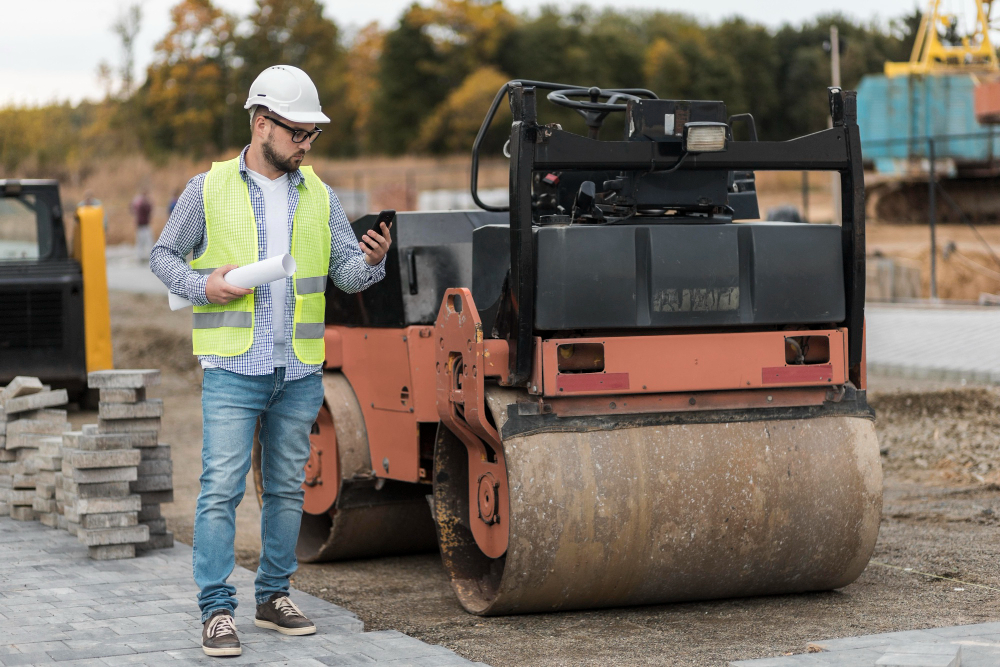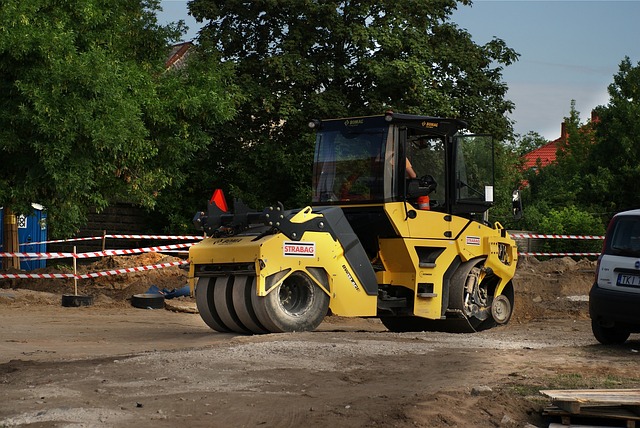The compactor is a tool which is used to push the soil or other ground materials downwards to remove spaces that have air and increase their density. Floor that has been made compact by the soil compactor can now easily support great loads of weight in a level surface, that is why construction teams can minimize the number of safety hazards.
Lands flattening machine can pave the ground in two main ways: static or vibratory. The former employs the machine’s weight to press the ground beneath, while the latter utilizes the movements and shakes of its vibrating component to reduce the space going from one particle to the next. By creating level surfaces for the heaviest equipment, compactors augment construction and landscaping teams in their work.
Three types of compactor from the compaction equipment family include the rammers, the plates, and the rollers. They each have a different range of motion and a different force applied. In a nutshell, rammers and plates are the smaller ones and they do not exert as much force. However, the dirt roller compactor, being of large size, covers a bigger surface as compared to the other two and with its heavy weight forces the materials to fit in consequently.
The 15 most commonly used and the most probable instances of how to use them are the subject of our guide.
1. Power Rammer
Power rammers, or trench rammers, are compactors that are useable manually unlike others, they are small enough to be held in hands, or workers can carry them on their back and walk vigorously up and down the trenches and ditches. But due to the small area they cover and the low output, it is best to use power rammers for local areas only. The working principle of a power rammer — physical impact with no vibrations involved — isn’t altered here.
2. Vibratory Tamper
Vibratory tampers have a little spring-loaded base plate to cause vibration. They vibrate more efficiently than a rammers impact, but their compression force is limited, therefore they are not as suitable for large plate compactor work. In contrast, like rammers, they are best suited for use in narrow quarters.
3. Vibrating Plate Compactors
A variety of vibrating plate compactors are available, with a wide weight range from 100 to 300 pounds of plate size. They are the largest in their class plates and can do about 10,000 vibrations per minute. Also, they can be used not only to compress small substances but also those in solid form like clay and sand.
4. Self-Propelled Roller
Guided rollers, such as pedestrian, hand-guided, and walk-behind rollers are among the many names given to self-propelled compactors, which are compacting machines that can be operated by hand. These types of machines are characterized by their drums that are normally not wider than two feet. Because they are expectedly less powerful than other types, they still need enough energy only they are smaller and fit into spaces.
5. Single Drum Vibratory Rollers
With a single drum vibratory roller, workers can now drive around with this machine to the working area. At the front of the cab, a vibrating drum is used allowing that area to be traversed and pressed while a pair of tires at the rear part keeps the machine from tipping over. Considering that it has one drum, maybe a few times of running it over the ground is needed before the compaction is done.
6. Large Dual Vibrating Drum Rollers
Dual vibrating drum rollers, also referred to as tandem rollers, have some similarities to their single drum counterparts. The only thing which makes the difference is an extra drum which is placed at the back of the machine. The added drum allows the operators to compact soil over the same area in a few runs only.
7. Smooth Wheel Rollers
Despite the capability soil and clay materials to be compressed, the design of smooth wheel rollers is more oriented to packing gravel, crushed rocks and sand. That’s why these machines are often used in the construction of highways and freeways. And while they provide the necessary traction, driving a smooth wheel machine would be a dangerous thing, especially on wet roads.
8. Static Roller
These rollers are employed only for static ground compression. Which means that they do not vibrate. They are usually equipped with two or three drums that serve as wheels. The static pressure from these drums is capable of leveling and smoothing out the surfaces that are still rough but because of the absence of vibration the machines can never be used to go deeper underground and compress the soil further.
9. Multi-Tire Pneumatic Roller
Pneumatic tire rollers are equipped with several tires at the front and back of the vehicle. Tires whose number is multiple and which are placed on two axels can work well only on the ground that is too weak in cohesion. And the rollers directly apply uniform pressure on a large surface, which reduces the risk of the soil collapsing. Moreover, they serve as fine particle carriers in asphalt mix by providing their finer particles to the surface.
10. Heavy Pneumatic Roller
Type: Roller: Heavy pneumatic rollers are used for the same operation as multi-tier pneumatic rollers. Operators can use these rollers because of their additional mass on fine silt and gravel. On the other hand, since the rise in weight is also an option, the rollers can penetrate deeper soil layers.
11. Sheepsfoot Roller
A sheepsfoot roller includes a steel drum with rectangular steel protrusions, also known as lugs or feet, along the drum surface. It is these feet that are especially suited for fine-grained soils and clays to the exclusion of other fabric types, know that it is the drum’s dimensions, weight, and the number of lugs that will affect the compaction quality. Teams normally employ these rollers in embankments, pavements, dams, and railway projects.
12. Elephantsfoot Roller:
Elephantsfoot rollers are the next line in sheepsfoot rollers, but they have some of their lugs replaced with a large flat plate welded on their remaining surface. This design feature enables the machine to perform best at soils with poor cohesion.
13. Padfoot Roller
Padfoot rollers, also known as tamping foot or slash presser rollers, contain lugs on their drums just like elephantsfoot rollers. Padfoot roller lugs have a huge footprint compared to the previous models. Viewed from the general point of view, therefore, they are able to give soil the more sitable conditions for subsequent mechanical operations. There are rare cases when these models are seen as the use of diamond-shaped lugs.
14. Grid Roller
A grid roller has a cylindrical surface made of steel bars that are interconnected and which form a steel grid. It’s functioning is quite simple. It crushes large rocks, while at the same time, the rocks are deposited beneath the soil due to a compact situation. One vehicle carrying another machine at the back is the common way an operator uses a grid roller.
15. Track Rollers
Track rollers are an unusual type of rollers in that they have a drum in front, but instead of wheels, they have two continuous tracks. The tracks make the machine even more reliable for compaction work and allow for a better top soil finish.
Benefits of a Compacting Machine
Compactors speed up the construction process, bring down the risks of damage or injury and are indispensable in case the site has exceptionally tight schedule requirements. While they are rarely the sole means of executing a project, the machines play a key role, not only in the cleaning up of a site but also in the most efficient use of the other devices. By using a soil compactor thoroughly, one can have the following benefits:
- Increased stability: Loose soil is riskier to move on than compacted one. The vertically moving devices like forklift trucks & cranes are some good examples. They benefit from the strengthened soil’s ability to move a stable, flat surface.
- Fewer water seepage problems: With soil compaction business, water leakages at the work site are minimized. Water passing through the compacted earth causes no harm to the equipment since it stays below the ground, thus not causing any disruption to the construction process. The compaction of soil is done with a soil compactor. Lifting devices can safely lift &carry heavier loads on stable, flat surfaces. Soil compaction equipment lets teams maximize their devices’ lifting capacity.
- Stronger materials: Increasing the density of a material or substance can be accomplished simply by pressing a compactor against it. The substance, for example, concrete can then become more resistant to harm due to the high-density that it possesses.
- Reduced water seepage: Water is an important consideration particularly when functioning with the machines at the surface of the earth. The water is free to move through the loose dirt and interfere with the work. Soil compaction technology keeps the water underground, preventing it from disturbing the work process.





